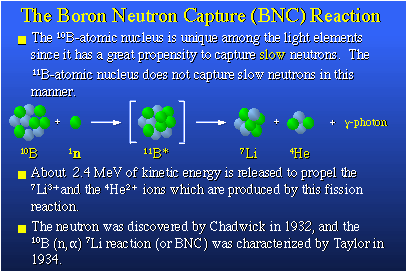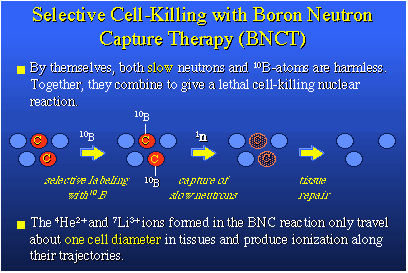|
|
Email: mfh@chem.ucla.edu |

I started by telling you there were two isotopes of boron, boron-10 and boron-11. Boron-10 is the only light element with an extremely high propensity to bind with a slow neutron that might present itself to the boron nucleus. That reaction is shown here. The boron-10 nucleus really likes neutrons that are moving slowly, so-called thermal neutrons. The boron-10 will pick up this neutron and form an excited boron-11 nucleus. This nucleus is unstable and it fissions, it actually blows up producing two heavy particles, a lithium-7 nucleus and a helium-4 nucleus, plus a gamma photon. About 2.4 million electron volts of kinetic energy are released in this process and that appears principally as translational energy in the two heavy particles, the lithium and the helium nuclei. They are heavy and they're moving rapidly. That makes them deadly to cells if they are created in tissue. I should give credit to the neutron discoverer, Chadwick, in England in 1932. The boron-10 neutron capture reaction was characterized first by Taylor and Fermi and others about 1934, and its application to medicine, which I will tell you about, was proposed in 1936. 
How would you apply this to medicine? The answer was produced by Locher, a physicist. The idea is if you have a tumor containing both normal cells, in blue, and cancer cells, in red and yellow, and the chemist by some hook or crook could selectively attach boron-10 to only the cancer cells, then you have boron-10 localized in the cells you wish to destroy. You then irradiate this whole region with slow neutrons, which are easily captured by boron-10, and then the boron neutron capture reaction, or BNC, should occur. The BNC will kill the cells to which the boron-10 target species was attached. Then the body repairs itself and these dead cells disappear. The nice thing about this process is that the ionization tracks of the helium and lithium ions produced from the fission reaction are only about one cell diameter in length and quite localized. The processes which lead to actual cellular death are the result of ionization tracking. The ions produced from the fission reaction are energetic and heavy on an atomic scale and they plow through the cell and virtually tear it to pieces. |